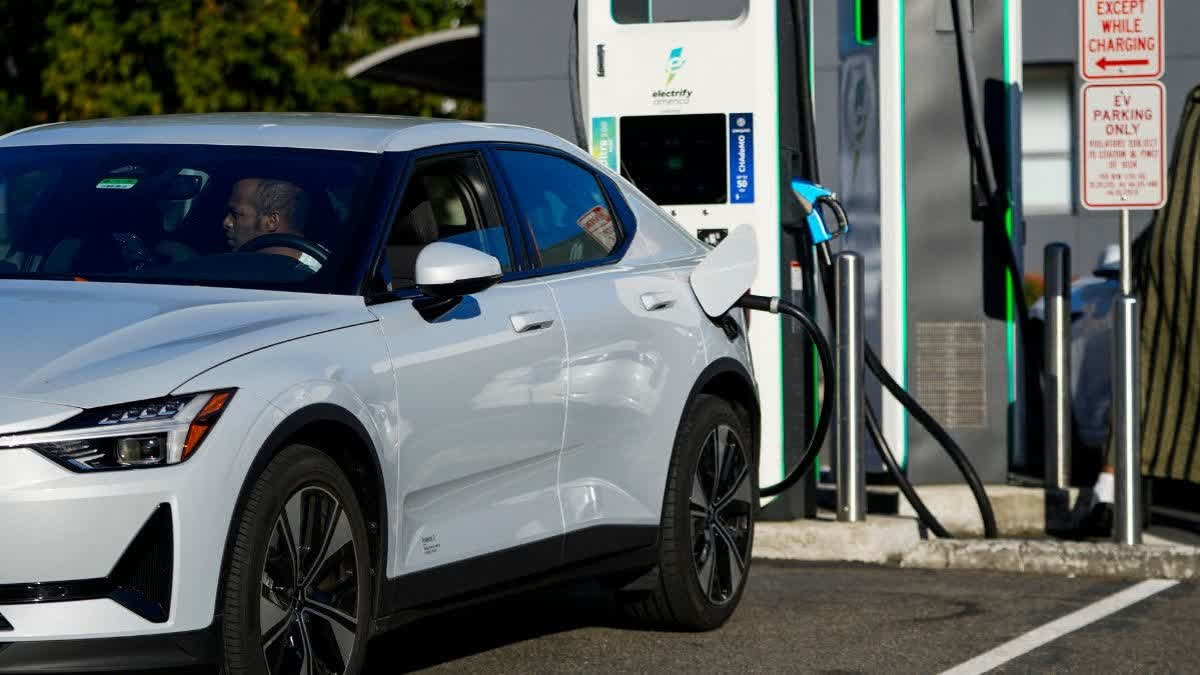New Delhi: India’s pursuit of its net-zero emissions target hinges on the rapid adoption of electric vehicles (EVs), as detailed in the FICCI-YES Bank report ‘Driving ZEV Transition – From Center to State.’ The report underscores the need for Zero Emission Vehicle (ZEV) penetration to grow by nearly 380 basis points (bps) annually to achieve the national goal of 30% EV adoption by 2030 (EV30@30).
Despite steady growth of approximately 200 bps annually between FY21-24, this pace falls short of the ambitious EV30@30 target. Sulajja Firodia Motwani, Chair of FICCI’s Electric Vehicle Committee and CEO of Kinetic Green Energy & Power Solutions told ETV Bharat, "The future of mobility in India is undoubtedly electric, and the remarkable progress we've made, backed by supportive government policies, is just the beginning."
"As many states’ EV policies near their sunset, it is imperative to urgently review and renew these policies with ambitious EV30@30 targets. A key industry demand is the renewal of road tax exemptions for EVs, which the report identifies as a critical enabler to sustain adoption momentum and market growth. The FICCI-YES BANK report 'Driving ZEV Transition – From Center to State' provides a comprehensive roadmap for accelerating India’s journey toward Zero Emission Vehicle leadership, emphasizing the need for robust state-level policies and collaboration between governments and industries to not only meet but exceed our EV aspirations," added Motwani.
State-Level Contributions: Leaders and Challenges
State-level policies are pivotal to India’s EV transition, the report reveals. Delhi leads EV penetration with 11.5%, followed by Kerala (11.1%) and Assam (10%), attributed to the widespread adoption of electric two-and three-wheelers. States like Gujarat, Odisha, and Punjab have achieved the highest Compound Annual Growth Rate (CAGR) in EV sales from FY21-24. However, as many state EV policies near expiration, the report calls for urgent renewals with updated targets and implementation plans to provide policy continuity and attract investor confidence.
- Delhi: EV penetration stands at 11.5%. It shows high eBus penetration at 57.6%
- Kerala: EV penetration is 11.1%. It leads in e4W penetration among the states
- Assam: EV penetration is 10%. The state shows strong adoption of e2Ws and e3Ws.
- Uttar Pradesh: Total EV volume in FY24 is 306,000, driven by its leadership in the e3W market
- Maharashtra: Total EV volume in FY24 is 211,000, with significant adoption of e2Ws (84,000 units)
- Karnataka: EV volume in FY24 is 167,000. It has a high share of e2W registrations (87,000 units)
- Tamil Nadu: FY24 EV volumes include 77,000 e2Ws, highlighting its strong adoption of this category
- Gujarat: Achieved a CAGR of 277% from FY21-24, driven by rapid growth in e2Ws and e3Ws
- Odisha: Recorded a CAGR of 233% between FY21-24, reflecting rising EV adoption
- Punjab: Achieved a CAGR of 222% from FY21-24, with increased EV adoption across all segments
- Bihar: Significant e3W adoption, contributing to its rising EV volume.
Recommendations for Accelerating EV Adoption
The report outlines a multi-pronged strategy to bridge the gap between EV adoption goals and execution.
1. Demand-Side Measures
- Extend fiscal incentives, such as road tax exemptions and subsidies
- Mandate EV adoption in public transport and fleet operations, including state transport buses, municipal vehicles, and last-mile delivery services
2. Supply-Side Interventions
- Focus on localization by building domestic EV value chains and fostering research and development (R&D)
- Encourage investments in EV manufacturing and assembly to establish a robust ecosystem
3. Infrastructure Development
- Develop a phased plan for charging infrastructure in rural and urban areas
- Ensure regular maintenance of EV chargers and implement systems to generate repair alerts for non-functional units
4. Policy Renewals and Progress Monitoring
- States must renew their EV policies with time-bound goals and regular progress reviews
- Institutionalize mechanisms for measuring the impact of these policies and making timely adjustments.
5. Institutional Support and Consumer Awareness
- Establish dedicated EV steering agencies to oversee policy implementation
- Launch awareness campaigns targeting small towns and rural areas to drive demand and educate consumers about the benefits of EV adoption
Transport: A Key Driver of Net-Zero Goals
The report identifies the transport sector as central to India’s net-zero commitment by 2070. A stronger focus on public-private partnerships and centralized coordination between states and industries is essential to accelerate ZEV adoption.
The Road Ahead
While the top five states accounted for over half of the country’s EV volumes in FY24, the spread of EV sales has improved over the past four years, highlighting the growing interest in electric mobility across India. The report emphasises the need for collaboration between the central and state governments to create a unified roadmap that ensures policy stability, encourages investments, and accelerates the transition to a sustainable transport ecosystem.



